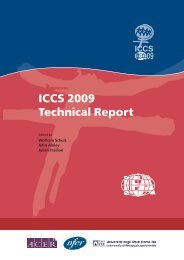Teacher Education and Development Study in Mathematics - IEA
Teacher Education and Development Study in Mathematics - IEA
Teacher Education and Development Study in Mathematics - IEA
Create successful ePaper yourself
Turn your PDF publications into a flip-book with our unique Google optimized e-Paper software.
PART 2: PHILIPPINES<br />
135<br />
<strong>in</strong> higher mathematics are certified to teach this subject <strong>in</strong> secondary school after tak<strong>in</strong>g<br />
five education courses <strong>and</strong> teach<strong>in</strong>g practicum(s), <strong>and</strong> pass<strong>in</strong>g the licensure exam<strong>in</strong>ation<br />
for teachers (LET-mathematics). It seems that attract<strong>in</strong>g qualified mathematics <strong>and</strong><br />
science teachers will be a necessary <strong>and</strong> key focus of education policy <strong>in</strong> the Philipp<strong>in</strong>es<br />
for years to come.<br />
<strong>Teacher</strong> education <strong>and</strong> recruitment<br />
Almost all higher education <strong>in</strong>stitutions <strong>in</strong> the Philipp<strong>in</strong>es offer st<strong>and</strong>ard four-year<br />
teacher education programs with relatively low tuition rates. 19 Most primary <strong>and</strong><br />
secondary school teachers earn Bachelor’s degrees <strong>in</strong>, respectively, elementary or<br />
secondary education; very few <strong>in</strong>dividuals earn Master’s degrees. Upper-secondary<br />
school teachers also study a major <strong>and</strong> m<strong>in</strong>or field as part of their secondary-level<br />
education degree (Agarao-Fern<strong>and</strong>ez & Guzman, 2005). Prospective teachers often take<br />
subject specialty courses with<strong>in</strong> their respective education degrees rather than tak<strong>in</strong>g<br />
separate subject-specific majors.<br />
There is a grow<strong>in</strong>g awareness that teacher education <strong>in</strong> the Philipp<strong>in</strong>es needs to<br />
transition away from general education <strong>and</strong> methods courses toward more subjectspecific<br />
content. For example, <strong>in</strong> 1997, around 50% of the teacher education program<br />
curriculum focused on general education. In 2004, however, the Commission on Higher<br />
<strong>Education</strong> set alternative curricular guidel<strong>in</strong>es that not only balanced the number of<br />
general education <strong>and</strong> subject-content courses but also emphasized professionalism, field<br />
study, <strong>and</strong> special topics courses (Agarao-Fern<strong>and</strong>ez & Guzman, 2005). Unfortunately,<br />
because of limited funds, most teacher education programs do not provide practical<br />
field tra<strong>in</strong><strong>in</strong>g for prospective teachers. In-service teachers have difficultly access<strong>in</strong>g<br />
professional development programs, aga<strong>in</strong> because of fund<strong>in</strong>g limitations.<br />
Upon graduat<strong>in</strong>g, prospective teachers must participate <strong>in</strong> the challeng<strong>in</strong>g LET, which<br />
had an annual pass rate of only 25% to 35% from 1996 to 2004 (Agarao-Fern<strong>and</strong>ez &<br />
Guzman, 2005). The low pass rate is perhaps due to the tenuous relationship between<br />
teacher education programs <strong>and</strong> exam<strong>in</strong>ation content, <strong>and</strong> to the fact that fewer<br />
than 30% of the teacher education programs <strong>in</strong> the Philipp<strong>in</strong>es meet the m<strong>in</strong>imum<br />
benchmark of the Commission for Higher <strong>Education</strong>. Many teachers secure their civil<br />
service status by fulfill<strong>in</strong>g the alternative requirement of teach<strong>in</strong>g for over 10 years;<br />
eventually, more than 70% of teachers do pass the exam<strong>in</strong>ation (BLES, 2003).<br />
In terms of recruitment, the Department of <strong>Education</strong> hires the largest proportion of<br />
teachers. In 1998 alone, the department recruited over 300,000 teachers <strong>and</strong> 33,000<br />
adm<strong>in</strong>istrative or supervisory staff (Acedo, 1999). The department’s hir<strong>in</strong>g process<br />
generally accounts for around 80% of its budget, crowd<strong>in</strong>g out funds that could improve<br />
other areas of education (Acedo, 1999). Acedo also noted <strong>in</strong> her 1999 report that teachers<br />
hired by the department had been <strong>in</strong>efficiently allocated <strong>in</strong> the previous years, either<br />
because of adm<strong>in</strong>istrative policies or the 1966 “Magna Carter for <strong>Teacher</strong>s,” which<br />
stipulates that teachers must agree to transfer to other schools as directed. Accord<strong>in</strong>g to<br />
Acedo, local school boards were us<strong>in</strong>g local funds to hire “supplementary teachers” to fill<br />
their community’s unmet preferences or needs, a practice that cont<strong>in</strong>ues today. These<br />
teachers are paid less because of limited local funds, even though they are (arguably) of<br />
comparable caliber to the teachers hired by the Department of <strong>Education</strong>.<br />
19 About 85% of the higher education <strong>in</strong>stitutions that provide teacher education programs are private; the rest are<br />
public. In addition, each region of the Philipp<strong>in</strong>es has at least 15 higher education <strong>in</strong>stitutions that provide teacher<br />
education programs (Agarao-Fern<strong>and</strong>ez & Guzman, 2005).

















